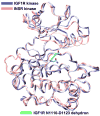Kinase packing defects as drug targets
- PMID: 17993409
- PMCID: PMC2136416
- DOI: 10.1016/j.drudis.2007.09.009
Kinase packing defects as drug targets
Erratum in
- Drug Discov Today. 2014 Apr;19(4):520
Abstract
Protein kinases constitute major targets in molecular cancer therapy. The structural conservation of kinases causes specificity problems in most drug inhibitors, often resulting in dangerous side effects. Here we survey recent approaches in drug design that exploit a molecular marker for specificity: the pattern of packing defects. These packing defects are solvent-exposed intramolecular hydrogen bonds that may be protected by drugs upon association. In this light, we review design strategies to achieve paralogue discrimination, to control cross reactivity and to overcome drug resistance induced by target mutations.
Figures






References
-
- Dancey J, Sausville EA. Issues and progress with protein kinase inhibitors for cancer treatment. Nat Rev Drug Discov. 2003;2:296–313. - PubMed
-
- Levitski A, Gazit A. Tyrosine kinase inhibition: an approach to drug development. Science. 1995;267:1782–1788. - PubMed
-
- Donato NJ, Talpaz M. Clinical use of tyrosine kinase inhibitors: Therapy for chronic myelogenous leukemia and other cancers. Clin Cancer Res. 2000;6:2965–2966. - PubMed
-
- Tibes R, et al. Tyrosine kinase inhibitors and the dawn of molecular cancer therapeutics. Annu Rev Pharmacol Toxicol. 2005;45:357–384. - PubMed
-
- Gibbs J, Oliff A. Pharmaceutical research in molecular oncology. Cell. 1994;79:193–198. - PubMed
Publication types
MeSH terms
Substances
Grants and funding
LinkOut - more resources
Full Text Sources
Other Literature Sources

